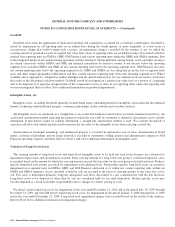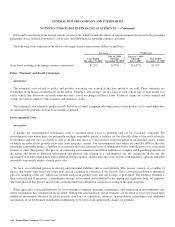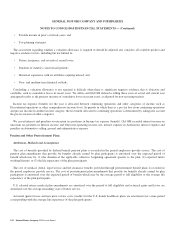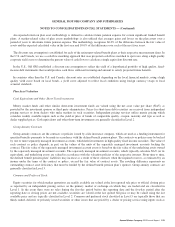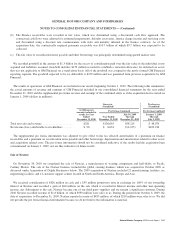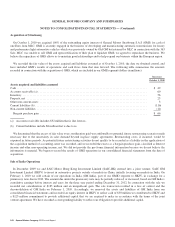General Motors 2010 Annual Report Download - page 159
Download and view the complete annual report
Please find page 159 of the 2010 General Motors annual report below. You can navigate through the pages in the report by either clicking on the pages listed below, or by using the keyword search tool below to find specific information within the annual report.GENERAL MOTORS COMPANY AND SUBSIDIARIES
NOTES TO CONSOLIDATED FINANCIAL STATEMENTS — (Continued)
classified in Level 1. Over-the-counter derivatives are typically valued through independent pricing services and are generally
classified in Level 2. Derivatives classified in Level 3 are typically priced by dealers and pricing services that use proprietary pricing
models which incorporate unobservable inputs. These inputs include extrapolated or model-derived assumptions such as volatilities
and yield and credit spread assumptions.
Due to the lack of timely available market information for certain investments in the asset classes described above as well as the
inherent uncertainty of valuation, reported fair values may differ from fair values that would have been used had timely available
market information been available.
Early Retirement Programs
An early retirement program was offered to certain German employees that allows these employees to transition from employment
into retirement before their legal retirement age. Eligible employees who elect to participate in this pre-retirement leave program work
full time in half of the pre-retirement period, the active period, and then do not work for the remaining half, the inactive period, and
receive 50.0% of their salary in this pre-retirement period. Program related benefits are recognized over the period from when the
employee signed the program contract until the end of the employee’s active service period.
Extended Disability Benefits
Estimated extended disability benefits are accrued ratably over the employee’s active service period using measurement provisions
similar to those used to measure our other postretirement benefits (OPEB) obligations. The liability is composed of the future
obligations for income replacement, healthcare costs and life insurance premiums for employees currently disabled and those in the
active workforce who may become disabled. Future disabilities are estimated in the current workforce using actuarial methods based
on historical experience. We record actuarial gains and losses immediately in earnings. Old GM amortized net actuarial gains and
losses over the remaining duration of the obligation.
Labor Force
On a worldwide basis, we have and Old GM had a concentration of the workforce working under the guidelines of unionized
collective bargaining agreements. At December 31, 2010 49,000 of our U.S. employees (or 64%) were represented by unions, of
which 48,000 employees were represented by the UAW. The current labor contract with the UAW is effective for a four-year term
that began in October 2007 and expires in September 2011. The contract included a $3,000 lump sum payment in the year ended
December 31, 2007 and performance bonuses of 3.0%, 4.0% and 3.0% of wages in the years ended December 31, 2008, 2009 and
2010 for each UAW employee. These payments are amortized over the 12-month period following the respective payment dates. In
February 2009 Old GM and the UAW agreed to suspend the 2009 and 2010 performance bonus payments.
Job Security Programs
In May 2009 Old GM and the UAW entered into an agreement that suspended the Job Opportunity Bank (JOBS) Program,
modified the Supplemental Unemployment Benefit (SUB) program and added the Transitional Support Program (TSP). These job
security programs provide employee reduced wages and continued coverage under certain employee benefit programs depending on
the employee’s classification as well as the number of years of service that the employee has accrued. A similar tiered benefit is
provided to CAW employees. We recognize a liability for these SUB/TSP benefits over the expected service period of employees,
based on our best estimate of the probable liability at the measurement date.
Prior to the implementation of the modified job security programs, costs for postemployment benefits to hourly employees idled on
an other than temporary basis were accrued based on our best estimate of the wage, benefit and other costs to be incurred, and costs
related to the temporary idling of employees were expensed as incurred.
General Motors Company 2010 Annual Report 157



